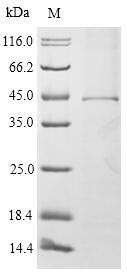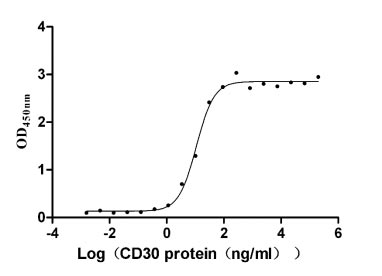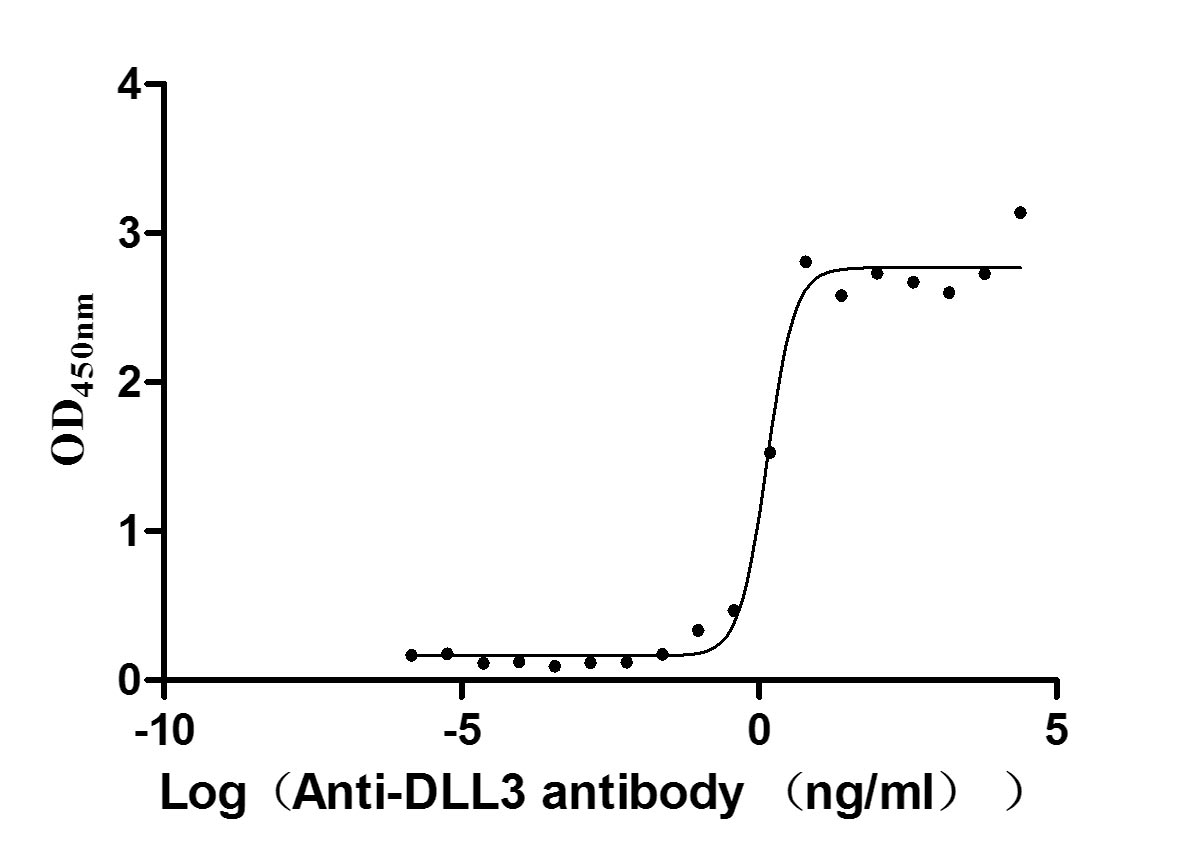Recombinant Mouse High affinity immunoglobulin epsilon receptor subunit alpha (Fcer1a)
In Stock-
中文名称:小鼠Fcer1a重组蛋白
-
货号:CSB-CF008532MO
-
规格:¥9720
-
图片:
-
其他:
产品详情
-
纯度:Greater than 90% as determined by SDS-PAGE.
-
基因名:
-
Uniprot No.:
-
别名:Fcer1a; Fce1a; High affinity immunoglobulin epsilon receptor subunit alpha; Fc-epsilon RI-alpha; FcERI; IgE Fc receptor subunit alpha
-
种属:Mus musculus (Mouse)
-
蛋白长度:Full Length of Mature Protein
-
来源:in vitro E.coli expression system
-
分子量:44.7kDa
-
表达区域:24-250aa
-
氨基酸序列ATEKSVLTLDPPWIRIFTGEKVTLSCYGNNHLQMNSTTKWIHNGTVSEVNSSHLVIVSATVQDSGKYICQKQGLFKSKPVYLNVTQDWLLLQTSADMVLVHGSFDIRCHGWKNWNVRKVIYYRNDHAFNYSYESPVSIREATLNDSGTYHCKGYLRQVKYESDKFRIAVVKAYKCKYYWLQLIFPLLVAILFAVDTGLLLSTEEQFKSVLEIQKTGKYKKVETELLT
Note: The complete sequence including tag sequence, target protein sequence and linker sequence could be provided upon request. -
蛋白标签:N-terminal 10xHis-SUMO-tagged
-
产品提供形式:Liquid or Lyophilized powder
Note: We will preferentially ship the format that we have in stock, however, if you have any special requirement for the format, please remark your requirement when placing the order, we will prepare according to your demand. -
缓冲液:Lyophilized from Tris/PBS-based buffer, 6% Trehalose
-
储存条件:Store at -20°C/-80°C upon receipt, aliquoting is necessary for mutiple use. Avoid repeated freeze-thaw cycles.
-
保质期:The shelf life is related to many factors, storage state, buffer ingredients, storage temperature and the stability of the protein itself.
Generally, the shelf life of liquid form is 6 months at -20°C/-80°C. The shelf life of lyophilized form is 12 months at -20°C/-80°C. -
货期:3-7 business days
-
注意事项:Repeated freezing and thawing is not recommended. Store working aliquots at 4°C for up to one week.
-
Datasheet & COA:Please contact us to get it.
相关产品
靶点详情
-
功能:Binds to the Fc region of immunoglobulins epsilon. High affinity receptor. Responsible for initiating the allergic response. Binding of allergen to receptor-bound IgE leads to cell activation and the release of mediators (such as histamine) responsible for the manifestations of allergy. The same receptor also induces the secretion of important lymphokines.
-
基因功能参考文献:
- House Dust Mite-Induced Allergic Airway Disease Is Independent of IgE and FcepsilonRIalpha. PMID: 28700253
- this study shows that mast cells co-cultured with macrophages alter protein expression of both cell types, and that mast cells transfer FceRI-encompassed cellular regions directly to macrophages during Francisella tularensis PMID: 27554051
- Tim-3 acts at a receptor-proximal point to enhance Lyn kinase-dependent signaling pathways that modulate both immediate-phase degranulation and late-phase cytokine production downstream of FcepsilonRI ligation. PMID: 26598760
- Conferring expression of FcepsilonRI to dendritic cells decreases the severity of food allergy and asthma in disease-relevant models suggesting anti-inflammatory IgE/FcepsilonRI signals. PMID: 25227985
- IgE-mediated activation of dendritic cells via IgE receptors binding in allergic Th2-type inflammation appears to be immune regulatory rather than pro-inflammatory. (Review) PMID: 26052071
- Specific cross-linking of the high affinity immunoglobulin epsilon receptor on the surface of bone marrow-derived mast cells and heart mast cells elicits the release of enzymatically active renin protein. PMID: 24262755
- Zinc-binding MT1 and MT2 are key modulators of Fc epsilonRI-induced basophil production of IL-4. PMID: 25801306
- Loss of Tespa1 in mouse mast cells led to hyper-responsiveness to stimulation via FcepsilonRI. PMID: 25422497
- IgE-mediated allergic hypersensitivity provokes release of renin from both cultured and resident cardiac mast cells. PMID: 24262755
- Overexpression of miR-142-3p enhances FcepsilonRI-mediated degranulation. PMID: 24361879
- OX40L engagement impairs FcepsilonRI activation and Gab2/PI3K/Akt, but not Syk/LAT, phosphorylation PMID: 22564682
- FcepsilonRI, but not FcgammaR, signals induce prostaglandin D2 and E2 production from basophils PMID: 21712025
- data implicate Fyn as the major positive mediator of STAT5 after FcepsilonRI engagement and demonstrate importantly distinct roles for STAT5A and STAT5B in mast cell function. PMID: 22130676
- Reduced IgE/antigen-mediated passive cutaneous anaphylaxis is detected in mice with Piga-deficient mast cells. PMID: 21865342
- The PI3K binding site is involved in FcepsilonRI-dependent ARF1 activation and granule translocation to the plasma membrane in the degranulation process, further dissecting the signals required for degranulation. PMID: 21653832
- Whereas FcepsilonRI required Lyn and Syk for NTAL phosphorylation, Kit appeared to directly phosphorylate NTAL. PMID: 17993265
- This is the first observation to attribute a spatiotemporally restricted antigen-presenting function to a subset of three-week old pure BMMC expressing both high levels of surface FcepsilonRI and surface major histocompatibility complex II. PMID: 20591187
- Peripheral blood basophils express approximately 50% of the Fc epsilon RI density of bone marrow (BM) basophils. A 3-fold greater synthetic rate of Fc epsilon RI on BM basophils readily explains the difference. PMID: 20042574
- Fc epsilon RI-mediated calcium flux (dependent on PLC gamma 1) leads to degranulation of mast cells independent of PI 3-kinase PMID: 13129935
- FcepsilonRI stimulation triggers the formation of microtubules in a manner independent of calcium. Drugs affecting microtubule dynamics effectively suppressed the FcepsilonRI-mediated translocation of granules to the plasma membrane and degranulation. PMID: 15998803
- SHIP and Src homology 2 domain-containing protein tyrosine phosphatase-1 interacted with FcepsilonRI beta, and their phosphorylation was controlled by Lyn. PMID: 16272347
- Fc receptor gamma RI interacts with the unrelated immunoreceptors FcalphaRI and FcepsilonRI PMID: 16627486
- The length of the stalk region of the alpha-chain is an important determinant of Fc epsilon receptor IA stability on the cell surface. PMID: 16709862
- IL-33 prolonged mast cell survival in the absence of IgE and impaired survival in the presence of SPE-7 IgE. PMID: 17881510
- These findings show that the extracellular domain of the type I transmembrane protein Fc epsilon RI alpha plays a role in Fc epsilon RI intracellular processing and expression at the cell surface. PMID: 18179824
- the high affinity of IgE for FcepsilonRI is critical to the allergic response, and that even moderate attenuation of this affinity has a substantial effect in vivo PMID: 18703499
- positive and negative regulators of FcepsilonRI have roles in mast cell activation [review] PMID: 19082920
- autoantibodies against Fcer1a is present in 30-50% urticaria patients PMID: 19331714
- Fc(epsilon)RIand CD16 thus contribute to atopic dermatitis but differentially regulate immune responses associated with the disease. PMID: 19414806
- the role of PI3Kgamma on the Fc epsilon RI mediated mast cell migration. PMID: 19494508
- Data suggest that PTPepsilon negatively regulates FcepsilonRI-mediated signalling pathways and thus constitutes a novel target for ameliorating allergic conditions. PMID: 19508371
显示更多
收起更多
-
亚细胞定位:Cell membrane; Single-pass type I membrane protein.
-
组织特异性:Expressed in bone marrow mast cells, as well as in the pineal gland at night.
-
数据库链接:
KEGG: mmu:14125
STRING: 10090.ENSMUSP00000056882
UniGene: Mm.5266
Most popular with customers
-
Recombinant Human Tumor necrosis factor ligand superfamily member 8 (TNFSF8), partial (Active)
Express system: Mammalian cell
Species: Homo sapiens (Human)
-
Recombinant Human Delta-like protein 3 (DLL3), partial (Active)
Express system: Mammalian cell
Species: Homo sapiens (Human)
-
Recombinant Human Complement component C1q receptor (CD93), partial (Active)
Express system: Mammalian cell
Species: Homo sapiens (Human)
-
Recombinant Human C-C chemokine receptor type 8 (CCR8)-VLPs (Active)
Express system: Mammalian cell
Species: Homo sapiens (Human)
-
Recombinant Mouse Cytotoxic and regulatory T-cell molecule (Crtam), partial (Active)
Express system: Mammalian cell
Species: Mus musculus (Mouse)
-
Recombinant Macaca fascicularis Cadherin 6(CDH6),partial (Active)
Express system: Mammalian cell
Species: Macaca fascicularis (Crab-eating macaque) (Cynomolgus monkey)
-
Express system: Mammalian cell
Species: Homo sapiens (Human)
-
Recombinant Human Mucin-13(MUC13),partial (Active)
Express system: yeast
Species: Homo sapiens (Human)





















